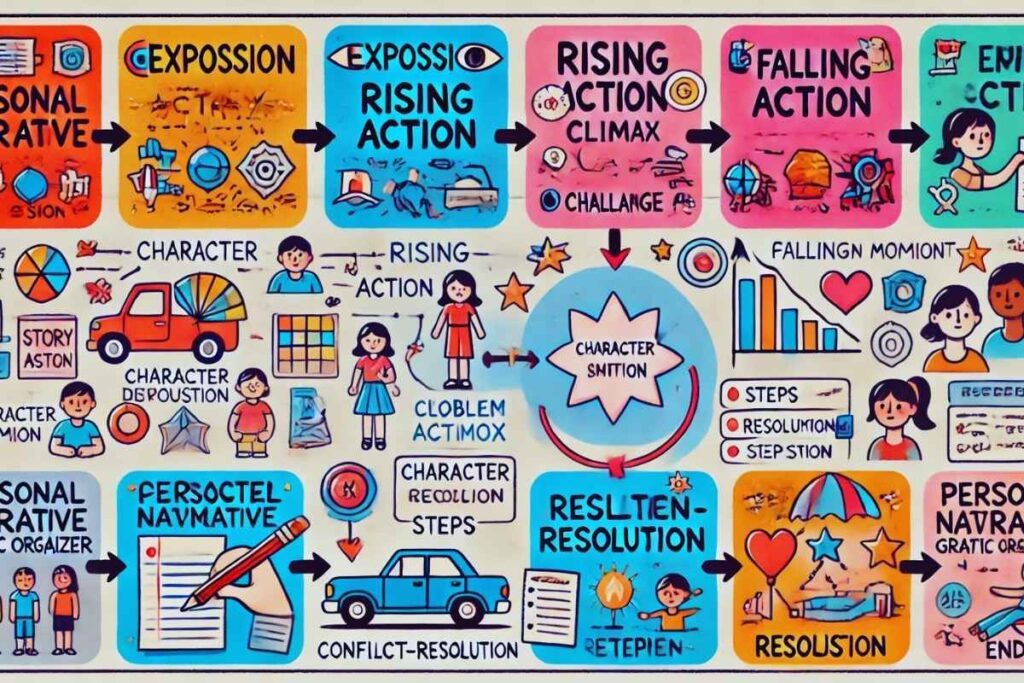A narrative graphic organizer is a powerful tool that helps writers structure their stories effectively. It provides a visual representation of key story elements, ensuring a logical and engaging flow of events.
Whether used in classrooms or by professional writers, these organizers enhance the storytelling process by breaking down narratives into essential components.
Understanding Graphic Organizers for Narrative Writing

A graphic organizer for narrative writing serves as a blueprint for constructing well-developed stories. By outlining the beginning, middle, and end, it helps writers maintain coherence and organization.
These tools are particularly useful for students learning to write narratives, as they simplify complex ideas into manageable parts.
Key Narrative Elements in Graphic Organizers
A well-structured graphic organizer narrative elements typically include:
- Exposition – Introduces characters, setting, and background information.
- Rising Action – Develops conflicts and builds suspense.
- Climax – The turning point or most intense moment of the story.
- Falling Action – Resolves conflicts and moves towards closure.
- Resolution – Concludes the story with a satisfying ending.
By using a narrative writing graphic organizer, writers can ensure that each part of the story receives appropriate attention, preventing disjointed or underdeveloped narratives.
Types of Narrative Graphic Organizers
There are several types of graphic organizer narrative elements, each catering to different writing needs:
- Story Maps: Help in visualizing the plot structure.
- Flowcharts: Outline the sequence of events step by step.
- Timeline Organizers: Assist in arranging events in chronological order.
- Character Development Charts: Aid in building dynamic characters with depth.
- Conflict and Resolution Diagrams: Highlight challenges faced by characters and their resolutions.
- Personal Narrative Graphic Organizer: Specifically designed to help writers develop personal stories by mapping out significant life experiences and their emotional impact.
Benefits of Using a Narrative Graphic Organizer

- Enhances Clarity – Writers can clearly see how their story unfolds.
- Encourages Organization – Ensures a well-structured plot.
- Sparks Creativity – Helps in brainstorming new ideas.
- Improves Writing Efficiency – Reduces writer’s block by providing a structured guide.
- Aids in Revision – Makes it easier to identify gaps or inconsistencies in the narrative.
How to Use a Narrative Graphic Organizer Effectively
- Choose the Right Organizer – Select one that suits your writing needs.
- Define the Story Elements – Fill in details for exposition, conflict, climax, and resolution.
- Visualize the Flow – Ensure a logical progression of events.
- Refine and Edit – Use the organizer to review and enhance the story.
- Finalize the Narrative – Convert the structured plan into a complete story.
Conclusion
A narrative graphic organizer is an invaluable tool for both novice and experienced writers. It simplifies the storytelling process, ensures coherence, and enhances creativity.
By utilizing a personal narrative graphic organizer, writers can craft compelling and well-structured stories that captivate their audience. Whether used in education or professional writing, these tools are essential for effective narrative development.
FAQs
What is a narrative graphic organizer?
A narrative graphic organizer is a visual tool that helps writers structure their stories effectively by outlining key elements like exposition, climax, and resolution.
Why should I use a narrative graphic organizer?
It enhances story clarity, improves organization, and boosts creativity by providing a structured framework for storytelling.
What are the main elements of a narrative graphic organizer?
The key elements include exposition, rising action, climax, falling action, and resolution, ensuring a well-developed story structure.
What types of narrative graphic organizers are available?
Common types include story maps, flowcharts, timelines, character development charts, and conflict-resolution diagrams.
Who can benefit from using a narrative graphic organizer?
Both students and professional writers can use these tools to create engaging and structured narratives.
How does a narrative graphic organizer improve writing efficiency?
It helps writers organize their thoughts, reduces writer’s block, and makes revision easier by identifying inconsistencies.
Can a personal narrative graphic organizer be used for different genres?
Yes, it works for various personal writing styles, including memoirs, creative nonfiction, and reflective essays.
How do I choose the right personal narrative graphic organizer?
Select an organizer based on your writing needs—story maps for plots, character charts for development, and timelines for sequencing personal events.
Can digital tools be used for creating a personal narrative graphic organizer?
Yes, many online tools and apps offer customizable templates for structuring personal narratives effective




